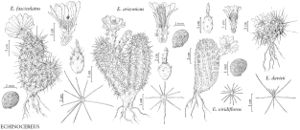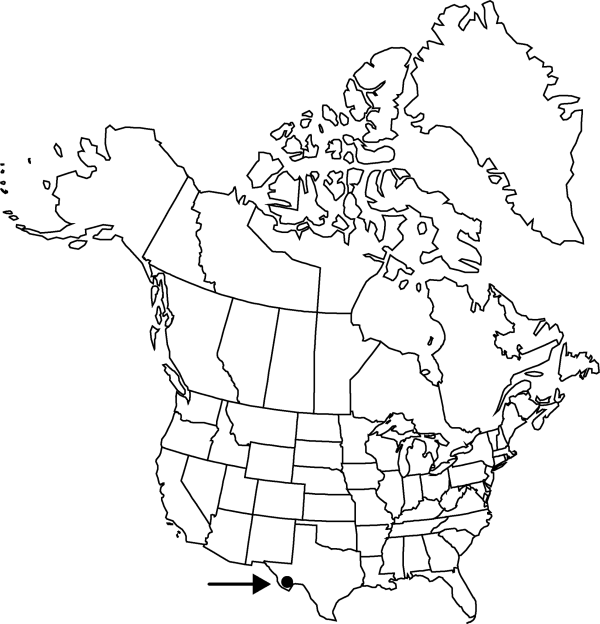Difference between revisions of "Echinocereus davisii"
Cact. Succ. J. (Los Angeles) 2: 466, fig. 1931.
FNA>Volume Importer |
imported>Volume Importer |
||
| (7 intermediate revisions by 2 users not shown) | |||
| Line 8: | Line 8: | ||
}} | }} | ||
|common_names=Davis’s hedgehog cactus | |common_names=Davis’s hedgehog cactus | ||
| + | |special_status={{Treatment/ID/Special_status | ||
| + | |code=F | ||
| + | |label=Illustrated | ||
| + | }}{{Treatment/ID/Special_status | ||
| + | |code=E | ||
| + | |label=Endemic | ||
| + | }} | ||
|basionyms= | |basionyms= | ||
|synonyms={{Treatment/ID/Synonym | |synonyms={{Treatment/ID/Synonym | ||
|name=Echinocereus viridiflorus var. davisii | |name=Echinocereus viridiflorus var. davisii | ||
|authority=(Houghton) W. T. Marshall ex Backeberg | |authority=(Houghton) W. T. Marshall ex Backeberg | ||
| + | |rank=variety | ||
}} | }} | ||
|hierarchy=Cactaceae;Cactaceae subfam. Cactoideae;Echinocereus;Echinocereus davisii | |hierarchy=Cactaceae;Cactaceae subfam. Cactoideae;Echinocereus;Echinocereus davisii | ||
| Line 20: | Line 28: | ||
}}<!-- | }}<!-- | ||
| − | --><span class="statement" id="st- | + | --><span class="statement" id="st-undefined" data-properties=""><b>Plants </b>tiny, usually unbranched in the wild, nearly covered by soil (often having only 2–5 areoles exposed). <b>Stems</b> erect, spheric, (1–)2–3 × 1–2(–2.5) cm; ribs 6–9, crests poorly defined, undulate; areoles of largest plants 6–7(–10) mm apart. <b>Spines</b> 8–14(–15) per areole, in relatively old plants curving irregularly in random directions, gray or white, some or all tipped black, dark reddish brown, or dull reddish purple; radial spines 8–14 per areole, ± pectinately arranged, (5–)10–15(–19) mm; central spines 0(–1) per areole, terete, 10–12 mm, closely resembling largest radial spines. <b>Flowers</b> 1.5–2 × 1.5–2(–2.7) cm; flower tube 5–8 × 5–10 mm; flower tube hairs very short, inconspicuous; inner tepals bright yellow-green, often with maroon midstripes, 9–18 × 2.7–3.8 mm, tips relatively thin and delicate; anthers yellow; nectar chamber 1 mm. <b>Fruits</b> purplish brown or remaining green when ripe, 5.5–9(–11) mm, pulp white. <b>2n</b> = 22.</span><!-- |
-->{{Treatment/Body | -->{{Treatment/Body | ||
| + | |phenology=Flowering Feb–Mar; fruiting 1 1/2-2 months after flowering. | ||
|habitat=Semidesert grasslands, novaculite outcrops | |habitat=Semidesert grasslands, novaculite outcrops | ||
|elevation=1200-1300 m | |elevation=1200-1300 m | ||
|distribution=Tex. | |distribution=Tex. | ||
| − | |discussion=<p>The relatively heavy, brown-and-white, often slightly contorted radial spines of Echinocereus davisii help to distinguish these tiny plants from seedlings of their larger congeners; remains of flowers and fruits, such as scattered flower tube spine-clusters, provide proof of sexual maturity. Echinocereus davisii is easily distinguished from E. viridiflorus; it is parapatric with E. viridiflorus without evidence of introgression. Echinocereus davisii is less compatible with E. viridiflorus than any varieties of E. viridiflorus are with one another (E. E. Leuck 1980).</p><!-- | + | |discussion=<p>The relatively heavy, brown-and-white, often slightly contorted radial spines of <i>Echinocereus davisii</i> help to distinguish these tiny plants from seedlings of their larger congeners; remains of flowers and fruits, such as scattered flower tube spine-clusters, provide proof of sexual maturity. <i>Echinocereus davisii</i> is easily distinguished from <i>E. viridiflorus</i>; it is parapatric with <i>E. viridiflorus</i> without evidence of introgression. <i>Echinocereus davisii</i> is less compatible with <i>E. viridiflorus</i> than any varieties of <i>E. viridiflorus</i> are with one another (E. E. Leuck 1980).</p><!-- |
| − | --><p>Echinocereus davisii is in the Center for Plant Conservation’s National Collection of Endangered Plants.</p> | + | --><p><i>Echinocereus davisii</i> is in the Center for Plant Conservation’s National Collection of Endangered Plants.</p> |
|tables= | |tables= | ||
|references= | |references= | ||
| Line 36: | Line 45: | ||
-->{{#Taxon: | -->{{#Taxon: | ||
name=Echinocereus davisii | name=Echinocereus davisii | ||
| − | |||
|authority=Houghton | |authority=Houghton | ||
|rank=species | |rank=species | ||
| Line 43: | Line 51: | ||
|basionyms= | |basionyms= | ||
|family=Cactaceae | |family=Cactaceae | ||
| + | |phenology=Flowering Feb–Mar; fruiting 1 1/2-2 months after flowering. | ||
|habitat=Semidesert grasslands, novaculite outcrops | |habitat=Semidesert grasslands, novaculite outcrops | ||
|elevation=1200-1300 m | |elevation=1200-1300 m | ||
| Line 49: | Line 58: | ||
|publication title=Cact. Succ. J. (Los Angeles) | |publication title=Cact. Succ. J. (Los Angeles) | ||
|publication year=1931 | |publication year=1931 | ||
| − | |special status= | + | |special status=Illustrated;Endemic |
| − | |source xml=https:// | + | |source xml=https://bitbucket.org/aafc-mbb/fna-data-curation/src/2e0870ddd59836b60bcf96646a41e87ea5a5943a/coarse_grained_fna_xml/V4/V4_325.xml |
|subfamily=Cactaceae subfam. Cactoideae | |subfamily=Cactaceae subfam. Cactoideae | ||
|genus=Echinocereus | |genus=Echinocereus | ||
|species=Echinocereus davisii | |species=Echinocereus davisii | ||
| − | |||
| − | |||
| − | |||
| − | |||
| − | |||
| − | |||
| − | |||
| − | |||
| − | |||
| − | |||
| − | |||
| − | |||
| − | |||
| − | |||
| − | |||
| − | |||
| − | |||
| − | |||
| − | |||
| − | |||
| − | |||
| − | |||
| − | |||
| − | |||
| − | |||
| − | |||
| − | |||
| − | |||
| − | |||
| − | |||
| − | |||
| − | |||
| − | |||
| − | |||
| − | |||
| − | |||
| − | |||
| − | |||
| − | |||
| − | |||
| − | |||
| − | |||
| − | |||
| − | |||
| − | |||
}}<!-- | }}<!-- | ||
-->[[Category:Treatment]][[Category:Echinocereus]] | -->[[Category:Treatment]][[Category:Echinocereus]] | ||
Latest revision as of 22:57, 5 November 2020
Plants tiny, usually unbranched in the wild, nearly covered by soil (often having only 2–5 areoles exposed). Stems erect, spheric, (1–)2–3 × 1–2(–2.5) cm; ribs 6–9, crests poorly defined, undulate; areoles of largest plants 6–7(–10) mm apart. Spines 8–14(–15) per areole, in relatively old plants curving irregularly in random directions, gray or white, some or all tipped black, dark reddish brown, or dull reddish purple; radial spines 8–14 per areole, ± pectinately arranged, (5–)10–15(–19) mm; central spines 0(–1) per areole, terete, 10–12 mm, closely resembling largest radial spines. Flowers 1.5–2 × 1.5–2(–2.7) cm; flower tube 5–8 × 5–10 mm; flower tube hairs very short, inconspicuous; inner tepals bright yellow-green, often with maroon midstripes, 9–18 × 2.7–3.8 mm, tips relatively thin and delicate; anthers yellow; nectar chamber 1 mm. Fruits purplish brown or remaining green when ripe, 5.5–9(–11) mm, pulp white. 2n = 22.
Phenology: Flowering Feb–Mar; fruiting 1 1/2-2 months after flowering.
Habitat: Semidesert grasslands, novaculite outcrops
Elevation: 1200-1300 m
Discussion
The relatively heavy, brown-and-white, often slightly contorted radial spines of Echinocereus davisii help to distinguish these tiny plants from seedlings of their larger congeners; remains of flowers and fruits, such as scattered flower tube spine-clusters, provide proof of sexual maturity. Echinocereus davisii is easily distinguished from E. viridiflorus; it is parapatric with E. viridiflorus without evidence of introgression. Echinocereus davisii is less compatible with E. viridiflorus than any varieties of E. viridiflorus are with one another (E. E. Leuck 1980).
Echinocereus davisii is in the Center for Plant Conservation’s National Collection of Endangered Plants.
Selected References
None.

